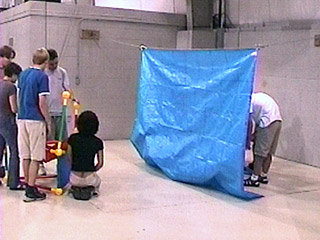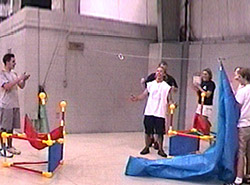Activity 14: Mirror and Match



Mirror Match Activity
Activity Plan
Group Size: 2 - 5/team
Time: 15 - 55 minutes
Mental Intensity: 3
Physical Intensity: 1
Space: Medium
Objectives
- Brainstorm problem-solving strategies to build a matching structure
- Work cooperatively and communicate effectively to build the structure
- Listen to team members
- Discuss the experience and their feelings
Character Focus
Communication
Preparation
Time: 5 minutes
Materials:
1 Toobeez set
1 tarp/curtain
1 envelope
chart paper (optional)
Setup:
- Place the Risk Taking Note into an envelope.
- Hang a large, opaque tarp between the teams.
- Divide Toobeez set evenly between the two teams.
The Challenge
The two teams, separated by a curtain, must build the exact same structure.
Safety Reminders!
Appropriate caution is important to conduct these activities in a safe manner. Be sure to review these reminders prior to beginning the activity, and if necessary, share reminders with the group during the activity.
- Follow general safety procedures
Helpful hints
- This activity is similar to Activity #8: Foggy Bridge Building found in this guide. This activity, however, is slightly easier. There is a LOT of talking in this activity
- This activity requires a great deal of clear communication and patience. It’s unlikely the group will achieve success by being lucky. They will most likely have to create a system they all understand; otherwise, too much will be left to guess work (guessing is common in the activity). If you see the group relying on guessing, ask the group about this or challenge this type of behavior
Activity Instructions
- Circle up the group. Distribute or display the appropriate “Risk Taking Note” for the activity. Have one participant read it aloud twice. Provide a few moments for the participants to think about the message:
When asked why he had a team of twenty-one assistants, Thomas Edison, said, “If I could solve all the problems myself, I would.” - Share the following storyline with group.
You are working to create two houses for two families that need the exact same structure. You have been given the job of helping these families have the homes they need! - Read aloud the following Activity Challenge Box to the group.
Challenge: The two teams, separated by a curtain, must build the exact same structure. Follow the guidelines below:- Teams must use all Toobeez pieces
- While the curtain is up, teams are not allowed to look at each other and they can’t look at each other’s Toobeez
- Nothing may touch or move the curtain
- Participants are only allowed to communicate verbally
- If any guidelines are broken, the group must begin again
- Before the participants attempt an activity challenge, have the group work through the following six steps:
- Circle up
- Know and understand the challenge and the guidelines
- Brainstorm
- Make a plan
- Do the plan
- Evaluate results and adjust as necessary
- There is no predetermined structure. That is, your groups do not have to build the structure like the one pictured in this guide. Through communication, the groups will build an original structure, but both of their structures must match.
- If participants get stuck, have the students circle up again. Here are some suggested questions to help guide the group back on track*:
- What is working?
- What ideas have you not tried yet that someone suggested?
- If your group is still struggling OR if you feel your group would benefit from an additional challenge, present a variation provided on the next page.
- When time is up, the curtain will be pulled away. The two sculptures must be identical in shape and form, however, colors of tubes do not have to match.
- After the activity, move to the debriefing questions for discussion.

Problem Solving Sequence:
Activity Variations
- Encouraging more communication.
Often times, there will be one or two key people on a team that end up doing most of the communicating. Consider asking these people to “take a vacation” for five minutes (a required leave of absence). This will require others to step up.
Debriefing the Activity
Use these debriefing questions as a guide for your discussion. Select the questions you feel will best benefit your group. It is not mandatory to cover every question. If possible, record the group’s responses on flip chart paper so all comments are displayed. Make sure to let everyone share their ideas, and remind participants that everyone’s opinions and feelings are important!
Base questions for debriefing:
- How did you feel while you did the activity?
- How did clear communication help you and your group during this activity?
- What was one of the challenges of doing this activity?
- To what degree do people rely on guessing?
- What advice would you give to another group working on this activity?
- How can you apply what you learned in this activity to your life and work?
- What surprised you about this activity?
If the group was unable to complete the task in the given time:
- What did a fellow team member do that was really helpful?
- Since you were not able to solve the problem, does it mean your group is a failure? (Push the group to respond with more than a “yes” or “no” and to instead point out and discuss what they learned.)
- How do you feel now?
Additional questions: Choose which ones are the most appropriate:
- What was one positive thing that happened during the challenge?
- How do you work to keep improving your work with others?
- Did you try different ideas and if so why did you change your approach?
Close on a Positive Note
Sum up the different ideas and feelings that you heard expressed, and restate ideas and learning moments the participants shared. Then, read the Risk Taking Note out loud again, and ask people to discuss what they think this note means. Discuss what they thought it meant at the beginning and what they think it means now.
* (ˆ) Do not provide the participants with answers. Allow them to work together.





